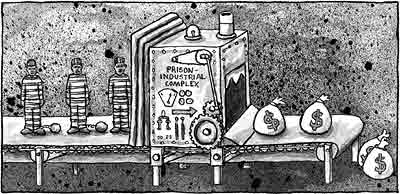
In the decades after World War II the American people built up the greatest and most broadly shared prosperity the world had ever know. That immense wealth attracted admirers. Millions wanted to be a part of it. Others wanted to own it.
Now, that wealth and the political power that goes with it are grotesquely concentrated among an ever smaller number of American citizens, in a way to rival the Roman aristocracy of ancient times or the European aristocracy which the first Americans threw off.
Democracy itself is threatened.
And the soul-less predators among the 1 percent want more, and are flexing their political muscle to get it. Like the remorseless killer of the James Bond movies, for them, “the world is not enough.”
Their next acquisition is the hard assets of the American people. Their siren song is “Privatization!”
The first target was carefully chosen: prisons.
Who cares about prisons, right? I mean, they’re full of criminals. But that is not how Wall Street sees prisons. They see a cheap and captive labor force.
And state by state, city by city, county by county, American prisons are being privatized and the prisoners put to work for their new owners, making an astounding array of products that are sold into the American market, to take market share and help drive down the wages of honest labor.
Prisoners are “paid” at about $1.25 per hour, to be spent in the company store; like the coal miners in the company towns of Pennsylvania and elsewhere until the mid 20th century.
Off-shoring has been done. Now, we can in-shore cheap labor. And don’t forget illegal immigrants. Wall Street hasn’t. The ones who get into the labor force drive down wages, and the others we can round up to keep the cells full and the private prisons profitable.
Hotel rooms, airline seats, prison cells — same profit and loss dynamic. Keep occupancy high and costs low.
High occupancy is achieved by (What else?) an army of lobbyists and campaign contributions, to insure ever more draconian prison sentences for non-violent and even minor offenses. When that fails, judges can be bribed to keep the cells full, as they have been in Pennsylvania.
Here is a how the CEO of one of the big private prison companies might explain cost control to a manager of one of the prisons they operate:
“You spent how much on blankets, clothing, food and medical care? And what the hell is this Internet access learning stuff? Rehab? These jerks aren’t going anywhere. We’re gonna keep ‘em right where they are, filling the cells. Look, I’m not about to lose my bonus because you can’t keep costs down. You wanna’ keep your job? Then get those costs down. And I mean now!”
The result, which came to light spectacularly in a juvenile prison in Texas, is shameful, even squalid living conditions.
The buying and selling of prison labor is the modern equivalent of 18th century slave auctions. Then, slaves were sold one by one on the auction block. Now, they are sold in gross lots.
The buyers are agents of the private prison companies, New York Stock (and livestock) Exchange listed. They show up in their $2,000 suits with 29-page power point presentations, telling the sellers — the elected officers of our governments — about all the money they can save taxpayers. (“And maybe there’ll be some stock in it for you. Know what I mean? ” Wink, wink.)
And the sellers, no fools they, bargain for the livestock. Because all sales are final.
“Look pal, we can guarantee you 3,000 prisoners a day, forever. And you want that for $50 million? Get real.”
What a thing for a proud parent to tell his children.
“What did you do today, Daddy?”
“Well honey, I sold our prisoners to a really fine company. Got a good price, too. Now you don’t have to think about them anymore.”
“Oh, thank you, Daddy.”
There is of course an alternative to this modern and immoral trafficking in human beings, as a means to reduce the cost of prisons borne by taxpayers: put fewer people in jail.
More than 2 million people are imprisoned in the U.S. today, more than the total for China and India combined — the populations of which are more than eight times that of the U.S. Two thirds of those in U.S. prisons have been sentenced for drug related and non-violent offenses. Many are non-whites who are far more likely than whites to be sentenced to prison and for longer terms.
In a hopeful sign, some states have begun to seek alternatives to packing the prisons, and to examine the draconian and mandatory prison terms enacted in the “law and order” mania that followed the social upheavals of the 1960s.
With the help of organizations like the Center for State Innovation and the Pew Center on the States, states such as Minnesota, Indiana and others are embracing new ideas and policies to insure public safety while at the same time reducing the prison population.
But there is a long way to go. The private prison pitch men are on the prowl, looking for elected officials who won’t mind trafficking in prisoners if they can wrap themselves in a balanced budget.
Originally published here
Image here
- All
- Agriculture
- Arts & Culture
- Book Reviews
- Civil Liberties
- Decentralism & The Vermont Tradition
- Education
- Empire and Overshoot
- Environment
- Featured Content
- Features
- Film Reviews
- Finance & Money
- Food
- Fuel & Energy
- Global Problems, Local Solutions
- Homestead Security
- Information & Media
- Interviews
- Military
- Most Likely to Secede
- Music Reviews
- Politics
- Resilience & Community
- Sovereignty & Secession
- Uncategorized
- Vermont Commons






You must be logged in to post a comment.